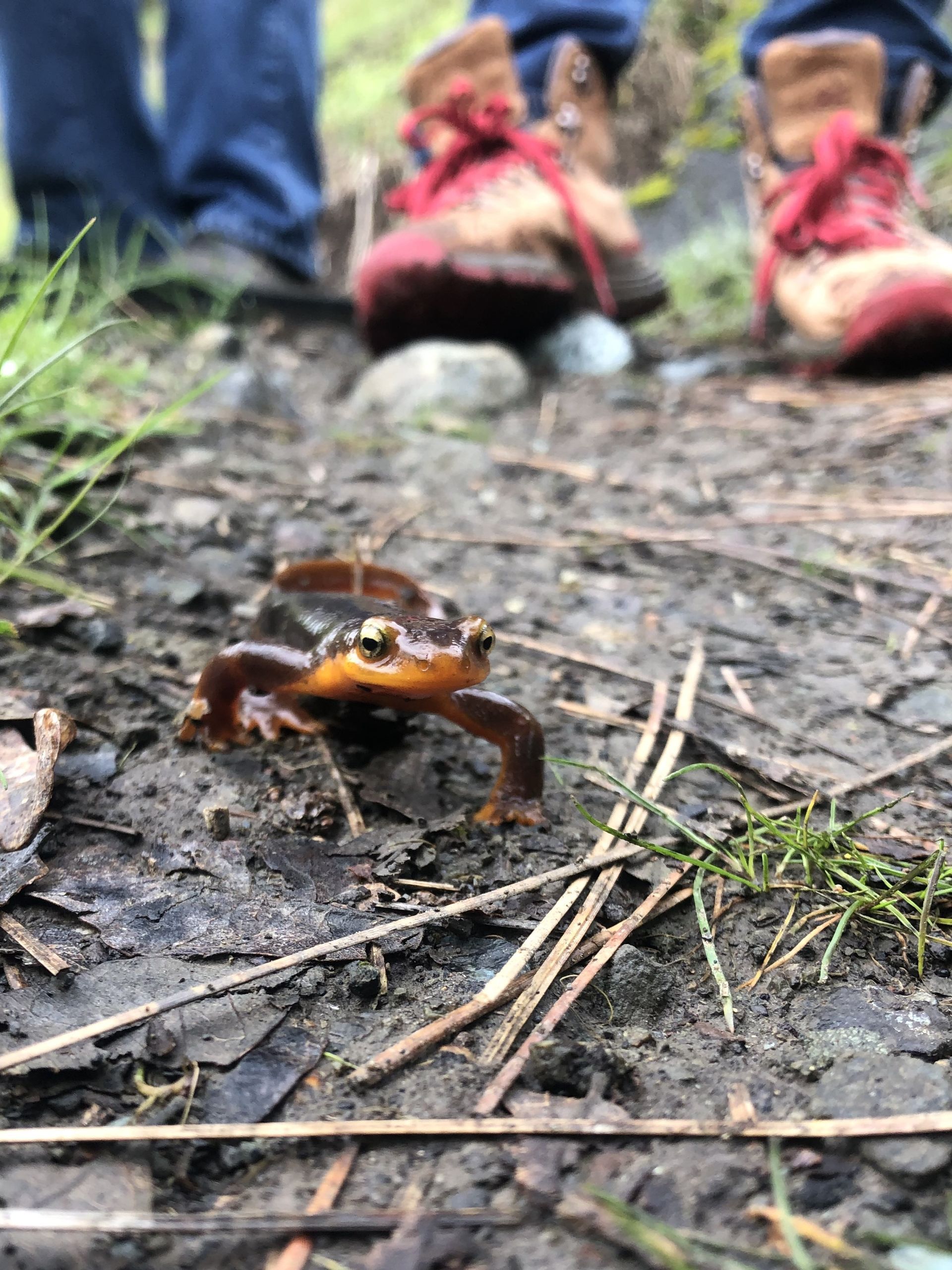Tuleyome's Science Corner - California Newts

Why did the newt cross the road? To find out, keep reading! I’ve seen oodles of them crossing Walker Ridge Road in the Berryessa Snow Mountain National Monument.
California newts, sometimes called orange-bellied newts are extra special because they are endemic to California, meaning they only occur here. They are found in grasslands, oak woodlands and chapparal near ponds and slow-moving creeks in California’s coastal counties, within the Coastal Range Mountains and the southern Sierra Nevada. There are two species of California newts: Coastal (Taricha torosa) and Sierra (Taricha sierrae); those occurring in the Berryessa Snow Mountain National Monument are the coastal species.
Adult California newts have rough, grayish-brown skin on their dorsal side and golden dark yellow to orange skin on their undersides. Although very similar to related species, California newts have lighter skin on their eyelids and under their eyes as well as a pale yellow or golden iris. Their eyes also protrude beyond their jaw line when viewed from above (like my chihuahuas). At maturity, adults range from about five to nearly eight inches long from their cute, blunt snouts to the tips of their paddle-like tails. Their skin produces a highly toxic venom called tetrodotoxin which causes death in many animals if ingested. Helpful hint: don’t snack on newts. Once they reach maturity, terrestrial adults roam but remain close to available water. Although adults may venture out after a rain, most of them find refuge for the hot, dry summer months in cooler, moist places such rock crevices, abandoned small mammal burrows or under woody debris. Reproduction begins when the adults reach around three years of age. Breeding season begins in late December and lasts roughly six to twelve weeks depending on weather conditions. Breeding adults typically migrate back to breed in the same body of water where they hatched. Some adults have been captured up to two miles away from their natal pond and then recaptured again back at the same pond to breed. Their journey back to their breeding pond may take several weeks and sometimes migrating newts are observed in large numbers. This might explain why the newt crossed the road!
Egg masses are attached to submerged vegetation or rocks and, as long as they remain just below the water surface, hatch after about fifty days. California newts begin life as aquatic larvae using gills to breath. As temperatures rise and ponded water begins to diminish, the aquatic larvae begin to transform into adults; gills are replaced by lungs and stumpy legs with webbed toes form. Interestingly, larvae do not produce tetrodotoxin and are preyed upon by a variety of animals. It is believed that nearby adults may release chemical signals that cue the larvae to take cover to avoid predation.
California newts are diurnal which means they are active during the day and night. Adults eat a variety of invertebrates including worms, insects, snails, slugs, as well as other amphibian eggs and larvae. Aquatic larvae feed on detritus, tiny aquatic invertebrates and possibly their brothers and sisters. When threatened, adult newts have quite a dramatic response; closing their eyes, extending their limbs and tails straight out and throwing their chins up. This exposes their orange underside, possibly as a warning to a predator that they are toxic. It seems to work as some newts are believed to have survived in the wild for about twenty years. Although very faint and difficult to hear, newts also make a series of sounds including clicks, squeaks and whistles. It hasn’t been determined how the sounds are produced but clicks seem to be the most commonly made sound and may be used to establish territory. Research shows that the squeaks may be a defensive sound and the whistles occur during breeding. California newts are currently a California Species of Concern as some populations have been greatly impacted by the introduction of non-native species such as mosquito fish (Gambusia spp.) and red swamp crayfish (Procambarus clarkia) as well as human caused impacts to their habitat.
Fun Fact: All newts are salamanders but not all salamanders are newts. Newts and salamanders do look similar at first glance and they seem to occupy similar niches making it seem difficult to tell them apart. The word “salamander” is the name of the scientific order of amphibians that have tails as adults. One difference between newts and salamanders is that newts spend most of their lives in water, hence the webbed toes and shorter, flattened tail to help them swim. Salamanders have well-developed toes and a round tail that resembles a lizard. Although they breed in water, salamanders spend the majority of their time on land.
Another Fun Fact: The common garter snake (Thamnophis sirtalis) and a few other species of garter snakes have developed a resistance to the toxin tetrodotoxin and successfully prey upon California newts. It’s also been documented that the amount of toxin and resistance varies by location and species.
If you would like to help protect the California Newt’s habitat, please join Tuleyome and our partners in expanding our favorite national monument.
-Kristie Ehrhardt (kehrhardt@tuleyome.org)
Tuleyome Land Conservation Program Manager
RECENT ARTICLES






